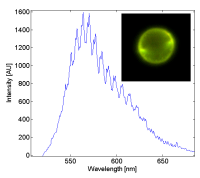Whispering Gallery Modes
Optical microcavities confine light in a very small volume. They are connected to a wide range of fields such as photonics, quantum electrodynamics (QED), atom optics and telecommunication. Possible applications are for example microlasers, narrow filters, optical switching, ultrafine sensing, displacement measurements, high resolution spectroscopy, Raman sources, enhancement and suppression of spontaneous emission and studies of nonlinear optical effects. Because of small volume of the microresonator the mode volume is much smaller than in large resonators. This means that the resonant frequencies are far apart from each other thus reducing the number of exited modes.
One type of microresonators are spherical resonators made of transparent dielectric spheres. If the refraction index of the sphere is grater than the index of the outside medium, the light can be trapped inside the sphere as a consequence of total internal reflection. If the circulating light returns to the same point in phase we get resonant standing waves. This resonant modes are called Whispering Gallery Modes (WGMs). The name comes from Whispering Gallery - the dome of St. Catherine’s cathedral in London where L. Rayleigh observed and analyzed sound bouncing of the dome walls.




